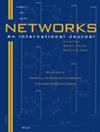Maximum weight perfect matching problem with additional disjunctive conflict constraints
IF 1.3
4区 计算机科学
Q4 COMPUTER SCIENCE, HARDWARE & ARCHITECTURE
引用次数: 0
Abstract
We focus on an extension of the maximum weight perfect matching problem with additional disjunctive conflict constraints in conjunction with the degree and binary restrictions. Given a simple graph with a nonnegative weight associated with each edge and a set of conflicting edges, the perfect matching problem with conflict constraints consists of finding a maximum weight perfect matching without any conflicting edge pair. Unlike the well‐known ordinary maximum weight perfect matching problem this one is strongly 𝒩𝒫 ‐hard. We propose two branch‐and‐bound algorithms for the exact solution of the problem. The first one is based on an equivalent maximum weight stable set formulation with an additional cardinality restriction obtained on the graph representing conflict relations and uses the information coming from its maximal stable sets. The second one is essentially a recursive depth first search scheme that benefits from simple upper bounds incorporated with a fast infeasibility detection procedure to prune the branch‐and‐bound tree. According to the extensive computational tests it is possible to say that they are both very efficient.附加析取冲突约束的最大权完全匹配问题
重点研究了带附加析取冲突约束的最大权值完美匹配问题的扩展,并结合了度约束和二元约束。给定一个具有非负权值的简单图和一组冲突边,冲突约束下的完美匹配问题包括寻找不存在冲突边对的最大权值完美匹配。不同于众所周知的普通的最大权值完美匹配问题,这个问题是强的硬的。我们提出了两个分支和定界算法来精确求解这个问题。第一种方法是基于在表示冲突关系的图上获得的等效最大权稳定集公式和附加的基数限制,并使用来自其最大稳定集的信息。第二种方法本质上是一种递归深度优先搜索方案,它得益于简单的上界和快速的不可行性检测过程来修剪分支和界树。根据大量的计算测试,可以说它们都是非常有效的。
本文章由计算机程序翻译,如有差异,请以英文原文为准。
求助全文
约1分钟内获得全文
求助全文
来源期刊

Networks
工程技术-计算机:硬件
CiteScore
4.40
自引率
9.50%
发文量
46
审稿时长
12 months
期刊介绍:
Network problems are pervasive in our modern technological society, as witnessed by our reliance on physical networks that provide power, communication, and transportation. As well, a number of processes can be modeled using logical networks, as in the scheduling of interdependent tasks, the dating of archaeological artifacts, or the compilation of subroutines comprising a large computer program. Networks provide a common framework for posing and studying problems that often have wider applicability than their originating context.
The goal of this journal is to provide a central forum for the distribution of timely information about network problems, their design and mathematical analysis, as well as efficient algorithms for carrying out optimization on networks. The nonstandard modeling of diverse processes using networks and network concepts is also of interest. Consequently, the disciplines that are useful in studying networks are varied, including applied mathematics, operations research, computer science, discrete mathematics, and economics.
Networks publishes material on the analytic modeling of problems using networks, the mathematical analysis of network problems, the design of computationally efficient network algorithms, and innovative case studies of successful network applications. We do not typically publish works that fall in the realm of pure graph theory (without significant algorithmic and modeling contributions) or papers that deal with engineering aspects of network design. Since the audience for this journal is then necessarily broad, articles that impact multiple application areas or that creatively use new or existing methodologies are especially appropriate. We seek to publish original, well-written research papers that make a substantive contribution to the knowledge base. In addition, tutorial and survey articles are welcomed. All manuscripts are carefully refereed.
 求助内容:
求助内容: 应助结果提醒方式:
应助结果提醒方式:


